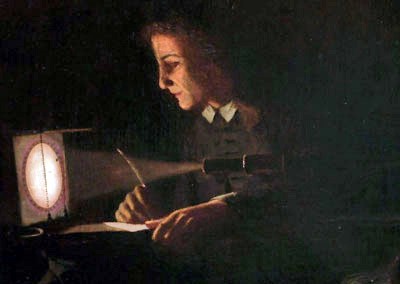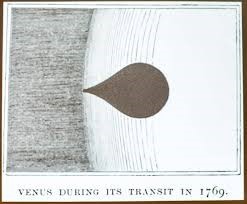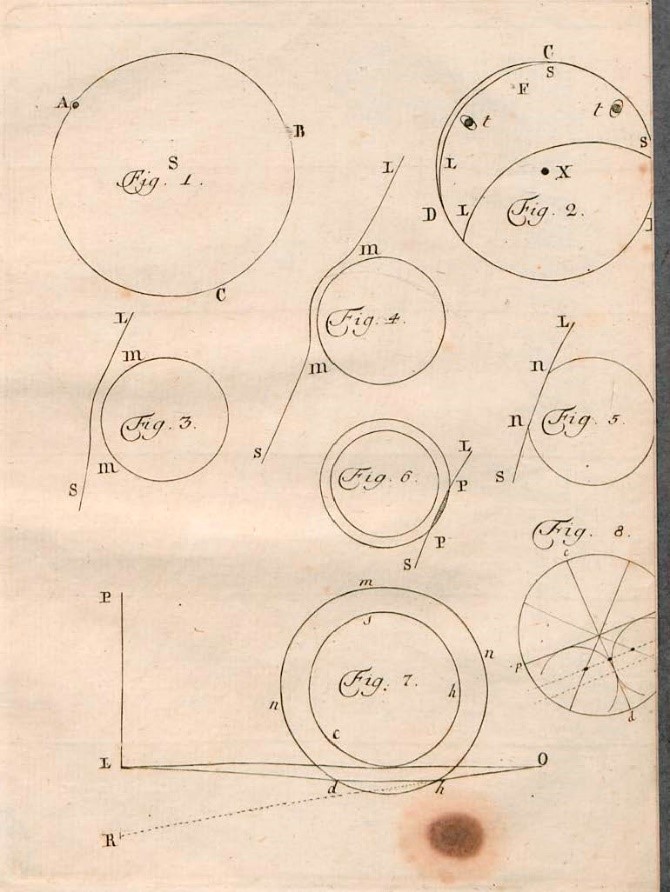In the 16th century, astronomy went from theological work to modern science. The most significant advance was the posthumous publication of “De revolutionibus orbium coelestium Commentariolus” by Copernicus around 1543. This book sets out the heliocentric principles in which the Earth and the wandering stars (the planets discovered at the time: Mercury, Venus, Mars, Jupiter and Saturn) orbit the Sun following circular orbits in opposition to the Ptolemy geocentric system taught at the time. This system was initially well received by the religious authorities who controlled knowledge at the time. They saw this simplicity as proof of the divine perfection of Creation. Research continues with Tycho Brahe, who makes numerous measurements of the positions of stray stars and reveals that their rotation is not perfectly circular. Kepler, who began as Tycho Brahe’s assistant, solved this problem by stating the first two laws that bore his name in Astronomia nova (1609). The first describes that the orbits are elliptical and not circular.
In the meantime, the theological situation had changed radically. With the philosopher Giordano Bruno who takes up the heliocentric principle to theorize an infinite universe and composed of a large number of other world. By removing the role of the centre of the universe from the Earth and then the Sun, this theory displeases the Church because it makes humanity lose its central place in divine Creation. The geocentric theses were thus repressed and Giordano Bruno executed in 1600.
It is at this moment that Venus returns to history, through Galileo. Galileo took up the principle of long sight to perfect it and use it for celestial observation. In 1610 he observed Venus and discovered that it appeared as the Moon in the form of a crescent. These phases correspond perfectly to a movement of a star rotating around the Sun, which reinforces the heliocentric theses. As repression continues, evidence accumulates and measures become more precise. Thanks to these new data and the geometric principle he himself laid down, Kepler was able in 1627 to predict transits of Venus. Transits do not cause a visible decrease in the brightness of the sun and therefore require a direct observation to be discovered. Moreover, they only occur for a few hours once or twice a century, which is too short to be observed by chance. Thus, this phenomenon was ignored until Kepler’s theoretical analyses were ignored. He predicted a first transit in 1631, but because of the vagueness of these measures, he could not determine that it would not be visible from Europe and was not observed. For the conjunction of 1636, Kepler predicted that Venus would narrowly miss the Sun. Despite this, the British duo Horrocks and Crabtree each used a solar image projection system and were able to observe for the first time a transit with certainty. In addition to refining the measurements of Venus, this observation allowed us to estimate the Earth-Sun distance at 95.6 million km (compared to 149.6 in reality) thanks to the method of solar parallaxes.

The next transit was planned by Kepler in 1761 and confirmed by later calculations as well as a second one in 1769. Between these two transits, astronomy completely changed its face from a few brilliant pioneers to structured learned societies. Although orbital geometry has been known since Kepler, Newton and Halley’s work made it possible to understand that they are governed by gravity, the action of which depends on the square of distance. The double transits of 1761 and 1769 were therefore an opportunity to measure the solar parallax and deduce the distance between Sun and Earth and the Paris observatory led the global observation effort. Despite the 7-year war that tore the world apart, passes were awarded to astronomers by all the belligerents, foreshadowing future international cooperation. These agreements allow for expeditions from the Urals to the remote islands of the Indian Ocean. They faced innumerable difficulties. In addition, local astronomers in many countries and in the American colonies and tahiti were added by the Cook Expedition. In order to coordinate all this work, the Paris Academy of Sciences broadcasts notes asking each participant to synchronize by observing distant events such as the surveys of the Jovian Moons. This makes it possible to determine precisely the longitude of the observation site. They must then determine precisely when Venus begins to appear in the solar disk, when it was totally there, and even do for the release of the disk if they can.
But things don’t go as planned. when Venus approaches the Sun, a crescent of light appears around the planet and ends up forming a circle around a black dot on the contour of the Sun. By penetrating deeper into the solar disk, the black dot deforms and creates a drop whose tail remains in contact with the edge of the Sun and prevents it from determining precisely when Venus fully penetrates the solar disk. The transit measures of 1761 were sent to the Paris Observatory, which took the opportunity to prepare the transit of 1769. Amateur astronomers, attracted by the emulation of this first transit, decided to join the observation program of the second. In addition, expeditions were sent and some, already in place, settled for 8 years refining their latitude measurements and studying their environment for other branches of science.
One can cite the story of Guillaume Le Gentil who went to observe, for an expedition of several months the transit of 1761 from Pondicherry (India), arrived too late. He decided to explore the Indian Ocean while waiting for the 1769 Ocean he missed because of the clouds. When he returned to France mad with rage after 11 years of fruitless travel (for the main purpose) he learned that these goods had been taken from him after he was declared dead for lack of news. Despite countless failed observations and the phenomenon of black drop that prevented a precise measurement, Jérôme Lalande managed in 1771 to synthesize enough data to estimate the value of the astronomical unit (average Earth-Sun distance) of 153 million km.

The century that separated the double transit of 1761/1768 and 1874/1882 was marked by great technological and knowledge progress. A large number of shipments are sent in much less risky conditions than in the previous century. The instruments are much more precise but the most emblematic advance is photography. The results are no longer interpreted by an observer and then drawn according to those memories of the moment. From now on, it is possible to take photos that forever fix the observation, and allow a multitude of researchers to review it on numerous occasions. Jules Janssen even goes so far as to invent a “photographic revolver” that allows to take a series of images of the entrance of Venus in the solar disk. This invention made it possible to make the first video sequences of the story and inspired the forerunners of cinema such as Jules Marey, Thomas Edison and the Light Brothers. Scientifically, observations of the transits of 1874 and 1882 made it possible to establish an astronomical unit at 149.9 million km, i.e. only 300,000 km of error.
The last two transits in 2004 and 2012 were obviously no longer used to determine the astronomical unit determined with new methods. They have mainly been used to make unfeasible atmospheric observations from a probe but above all they have allowed to develop a new method of detection of exoplanets. Indeed, with the increase in accuracy, measuring instruments have allowed astronomy to focus on the search for planets outside the solar system. The first method of studying the movement of the star (with its shift to red) allows to deduce only the presence of extremely massive planets like Jupiter. The 2004 transit allows us to analyze precisely what can be observed from the passage of an Earth-sized planet in front of the sun and to generalize these observations to deduce the presence of a planet when it passes in front of its star. Today, the glider transit technique has detected the majority of exoplanets currently known and all those of small size.

Returning to the transits of 1761 and 1769, visual disturbances may have reduced the accuracy of the measurements, but they are still instructive. Mikhail Lomonosov deduced that the planet has an atmosphere thanks to the presence of an arc (which today bears his name) around Venus at the time of its entry into the solar disk. The black drop phenomenon that had so disrupted the measurements was also attributed to this atmosphere, but subsequent analyses showed that this was due to earth atmospheric disturbances and diffraction on the lenses of the glasses. The study of this atmosphere and this planet continues happily during the years between the double transits. Increased eyeglass performance made it possible to make direct observations outside transits and to collect additional clues such as the bevelled shape of the crescents and the luminous halo surrounding it during the conjunctions. Some observers also thought they saw mountains or elements of terrain and tried to deduce the length of the days. Estimates gave 24 hours, but it was finally concluded that a cloud layer covers the entire surface and that the reliefs are actually permanent changes in clouds.